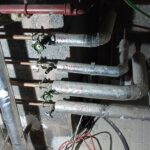1. Lead Contamination and Health Hazards
Lead pipes, especially those that have aged or corroded, can leach toxic lead particles into the water supply. This contamination poses serious health risks—ranging from hypertension and gastrointestinal issues to irreversible neurological damage. Even low levels of lead exposure are harmful, particularly to children and pregnant women.
2. Legionella and Waterborne Risk
Legionella bacteria, the cause of Legionnaires’ disease—a severe type of pneumonia—can flourish in water systems where specific conditions support their growth. Lead plumbing is one such contributor.
3. Biofilm Development on Aging Infrastructure
The internal surfaces of old lead piping tend to be uneven and rough, encouraging the accumulation of biofilms. These slimy microbial layers offer protection and a stable environment for bacteria, including Legionella, to multiply.
4. Nutrients from Pipe Corrosion
Corroded metal pipes, particularly those containing lead, can introduce elements into the water that act as nutrients. These metals may serve as a growth enhancer for Legionella, making the system more susceptible to bacterial colonization.
5. A Perfect Storm for Bacterial Proliferation
The combination of nutrient availability from corrosion, increased biofilm presence, and stagnant conditions often found in outdated piping systems creates an ideal breeding ground for Legionella bacteria. This not only elevates the risk of contamination but also allows the pathogen to potentially disperse throughout a building’s entire water network













Leave a Reply
You must be logged in to post a comment.